Contents:
- CRZ rules eased for ‘Blue Flag’ beaches
- Iran nuclear deal: EU launches dispute mechanism
- ASER Study: Gender Disparity in Education system
- Improving the Credibility of India’s Statistical System
- Anti-profiteering body steps up GST compliance drive
- How India is Resetting its ties with the World
- SC rejects curative pleas of 2 Nirbhaya death row convicts
- Kerala govt. challenges CAA in Supreme Court
CRZ RULES EASED FOR ‘BLUE FLAG’ BEACHES
Why in news?
The Environment Ministry has relaxed Coastal Regulation Zone (CRZ) rules that restrict construction near beaches to help States construct infrastructure and enable them to receive ‘Blue Flag’ certification.
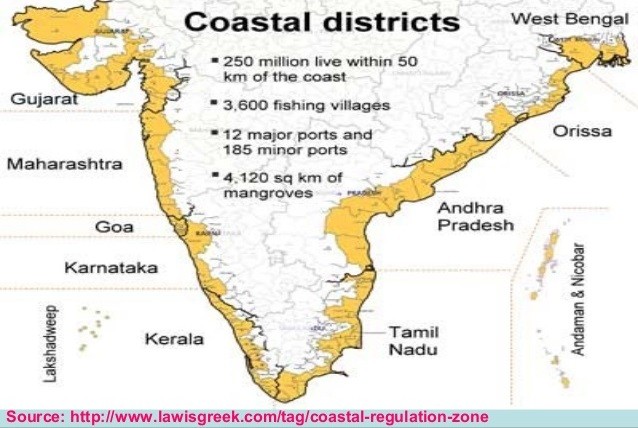
More about Blue Flag Certification
- The Blue Flag Programme started in France in 1985 and has been implemented in
- Europe since 1987, and in areas outside Europe since 2001.
- The Blue Flag is a certification by the Foundation for Environmental Education (FEE) that a beach, marina, or sustainable boating tourism operator meets its stringent standards.
- FEE’s Blue Flag criteria include standards for quality, safety, environmental education and information, the provision of services and general environmental management criteria.
- The Blue Flag is sought for beaches, marinas, and sustainable boating tourism operators as an indication of their high environmental and quality standards.
IRAN NUCLEAR DEAL: EU LAUNCHES DISPUTE MECHANISM
Why in news?
Britain, France and Germany ratcheted up pressure on Iran on 14th January to cease its violations of a landmark nuclear deal, stressing that they want to resolve differences through talks.
More about dispute resolution mechanism
- Under JCPOA dispute resolution mechanism, countries have 30 days to resolve their problem, though that can be extended.
- If it cannot be solved, the matter could be brought before the UN Security Council and could then result in the snapback of sanctions that had been lifted under the deal.
Background
- The 2015 nuclear deal, known as the Joint Comprehensive Plan of Action, or JCPOA, seeks to prevent Iran from producing a nuclear weapon — something Iran insists it does not want to do — by putting curbs on its atomic programme in exchange for economic incentives.
ASER STUDY: GENDER DISPARITY IN EDUCATION SYSTEM
Why in news?
- The Annual Status of Education Report (ASER) was released on 14th January.
- The report is based on a survey to assess learning outcomes in school-going children.
- The report was conducted in 26 districts across 24 states by education non-profit Pratham.
- It revealed gender disparity in parents opting for private schools over government schools for kids aged 4-8.
What does the report show:
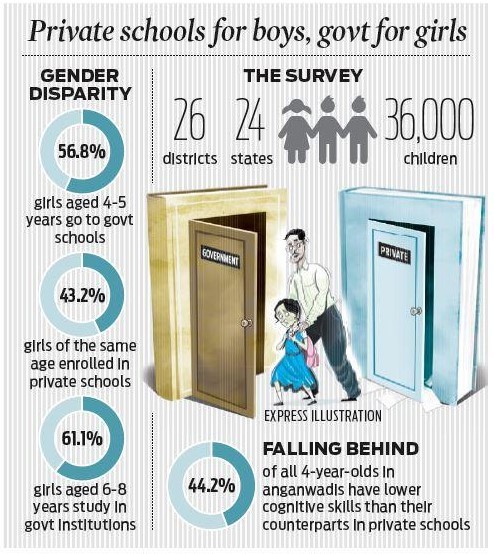
- The report shows at least 35% students lack age-appropriate skills; Education system is failing kids in 4-8 age group
- At least 25% of school children in the four-eight age group do not have age-appropriate cognitive and numeracy skills, making for a massive learning deficit at a very early stage.
- The government-run preschool system is losing out to private schools in terms of enrolment, said ASER 2019, which this year focuses on early education.
- The lack of age-appropriate skills is alarming as this gap at an early age can impact the entire education supply chain in India.
- Just 37.4% of children below six are able to recognize at least letters and only 25.6% can do additions, according to the report.
- Similarly, only 34.8% of children in Class II can read a text meant for the level below.
- And at Class III, only 50.8% can read texts meant for their juniors two levels below.
Highlights
- The report underlined the need to focus on the early years to improve the basics of education.
- A focus on the “breadth of skills” and activities that strengthen cognitive skills rather than formal subject-learning in the early years may generate substantial benefits for later academic performance, it said.
- The study also showed how a better education level among mothers can lead to better outcomes among children in preschools and early schools.
- The findings also showed that more girls are enrolled in government institutions and more boys in private institutions.
- Among four-five year-old children, 56.8% of girls and 50.4% of boys were enrolled in government schools or preschools, whereas 43.2% of girls and 49.6% of boys were enrolled in private preschools or schools, the survey found.
- The gap in enrolment between boys and girls is larger among 6-8 year olds, with 61.1% of all girls versus 52.1% of all boys in this age group going to a government institution.
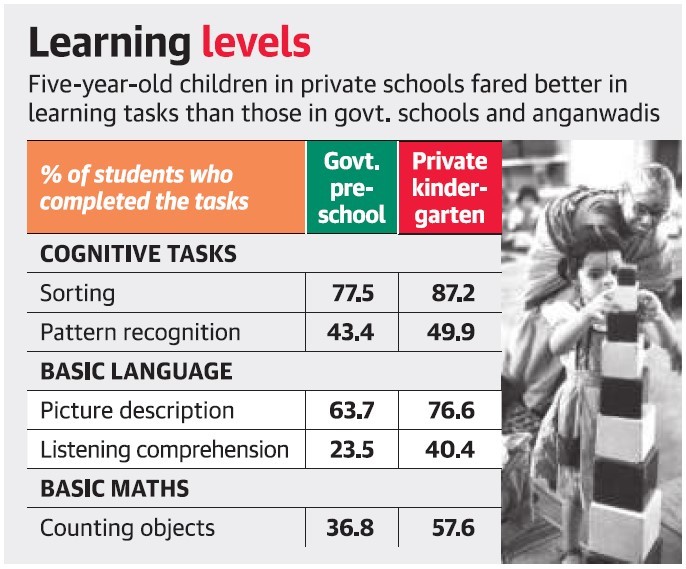
Way forward
- Most of the young mothers in the next decade will not be very young as the median age of marriage has increased over the years from 18.2 years in 2001 to nearly 21.7 in rural India and 23.4 in urban India by 2016. There is also the improvement of education among women. Such changes in the profile of young Indian mothers need to be taken into account when thinking of the education inputs to be designed for the young children.
- Coherence between central ministries is essential for improving early childhood education policymaking
- It is also better to encourage state and district administrations to have a greater say to make early education effective.
Background
- ASER stands for Annual Status of Education Report.
- This is an annual survey that aims to provide reliable estimates of children’s enrolment and basic learning levels for each district and state in India.
- ASER has been conducted every year since 2005 in all rural districts of India. It is the largest citizen-led survey in India.
- It is also the only annual source of information on children’s learning outcomes available in India today.
- ASER tools and procedures are designed by ASER Centre, the research and assessment arm of Pratham.
- The survey itself is coordinated by ASER Centre and facilitated by the Pratham network.
- The government preschool system is managed through the Centre’s Integrated Child Development scheme, under the ministry of women and child development, while schools come under the education ministries at the Centre and in the states.
IMPROVING THE CREDIBILITY OF INDIA’S STATISTICAL SYSTEM
Why in news?
A study by R.B. Barman, the former chairman of the National Statistical Commission shows: it is important to directly address the issues in growth calculations, and also to restore the credibility of the Indian statistical system
Suggestions by Barman
- Mapping the Annual Survey of Industries (ASI) data, which was used in earlier GDP calculations, with the new corporate affairs ministry data (MCA-21) used in the current GDP calculations.
- This could fill in the gaps and better reconcile GDP and gross state domestic product numbers with old estimates.
- Use of better price deflators in GDP calculations. Deflators are price indices used to adjust GDP for inflation.
- Create regular processes within the Central Statistics Office (CSO) for systematically testing for data consistency.
- The difference between estimates on household consumption based on the National Sample Survey Office (NSSO) surveys and the CSO data, which are large and widening over time, need to be addressed.
- The government could develop a well-integrated and advanced information technology infrastructure for producing more insightful and comprehensive macroeconomic data.
- The recent draft National Statistics Bill, if enacted, would improve accountability and credibility of Indian statistics.
Background
MoSPI
- The Ministry of Statistics and Programme Implementation (MoSPI) is concerned with coverage and quality aspects of statistics released and the surveys conducted are based on scientific sampling methods.
- MoSPI has two wings, one relating to Statistics and the other Programme Implementation.
- The Statistics Wing called the National Statistical Office(NSO) consists of the Central Statistical Office (CSO), the Computer center and the National Sample Survey Office (NSSO).
ASI
- Annual Survey of Industries (ASI) is conducted by National Sample Survey Office (NSSO).
- ASI is principal source of industrial statistics in India.
- ASI is an annual event.
- It facilitates suitable data collection based on appropriate sampling techniques.
- It ensures timely dissemination of statistical information to asses and evaluate the dynamics in composition, growth and structure of organized manufacturing sector.
MCA-21
- MCA21 is an e-Governance initiative of Ministry of Company Affairs (MCA), Government of India.
- It enables an easy and secure access of the MCA services to the corporate entities, professionals and citizens of India.
- It Enables the business community to register a company and file statutory documents quickly and easily.
- It Provides easy access of public documents
- It Helps to Provide faster and effective resolution of public grievances
- It also Helps in easy registration and verification of charges
- It Ensures proactive and effective compliance with relevant laws and corporate governance
- It Also Enables the MCA employees to deliver best of breed services
CSO
- The Central Statistics Office (CSO) coordinates the statistical activities in the country and evolves statistical standards.
- It is a governmental agency in India under the Ministry of Statistics and Programme Implementation (MoSPI).
NSSO
- The National Sample Survey Office (NSSO), formerly called the National Sample Survey Organisation was the largest organisation in India conducting periodic socio-economic surveys.
- The NSSO was set up in 1950 to conduct large-scale sample surveys throughout India. The employees of the NSSO are from the Indian Statistical Service (appointed through the UPSC) and the Subordinate Statistical Service (appointed through the Staff Selection Commission).
ANTI-PROFITEERING BODY STEPS UP GST COMPLIANCE DRIVE
Why in news?
A wave of orders is expected from the National Anti-profiteering Authority (NAA) in the months of February, March and April of 2020, with the Centre stepping up a goods and services tax (GST) compliance drive.
Background
- The National Anti-profiteering Authority (NAA) was established under section 171 of the Central Goods and Services Tax Act, 2017.
- The NAA was set up to monitor and to oversee whether the reduction or benefit of input tax credit is reaching the recipient by way of appropriate reduction in prices.
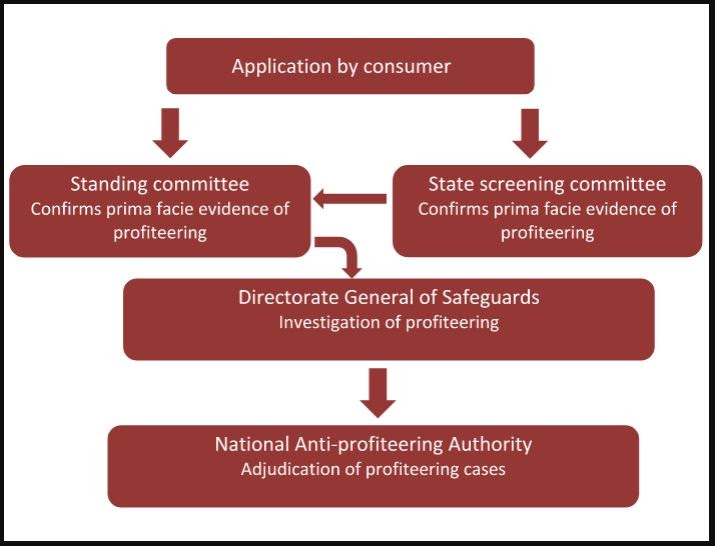
- National Anti-profiteering Authority (NAA) is therefore primarily constituted by the central government to analyse whether input tax credits availed by any registered person or the reduction in the tax is passed onto the consumer and he/she is protected from random price increase for self-interests in the name of GST.
- NAA has the authority to deregister an entity or business if it fails to pass on the benefit of lower taxes under GST to the customer.
- Deregistering a business will be the last course of action and extreme step against any violator
- NAA will recommend the return of undue profit which a business earned from not passing on reduction and benefit of tax to consumers along with an 18 per cent interest. It can also impose a penalty if it sees it necessary.
HOW INDIA IS RESETTING ITS TIES WITH THE WORLD
Why in news?
India’s shift in trade strategy is evident from its decision to opt out of RCEP and the increasing engagement with the US and EU.
Details
- India announced its exit from the China-led Regional Comprehensive Economic Partnership (RCEP) deal at the Bangkok summit on 4 November.
- While countries like Japan are still trying to woo India back to the RCEP fold, India has now signaled a shift in strategy when it comes to signing free trade agreements.
- It is now showing readiness to renew negotiations on the long-pending free trade agreement (FTA) with the European Union as well as with Britain after the impending Brexit deal is signed.
- India is currently negotiating a limited trade package with the US after which both sides may sit down for a comprehensive FTA negotiation.
India’s FTAs
- Negotiations for the proposed India-EU FTA started in 2007 but talks were suspended in 2013 due to differences.
- FTAs with EU and the US have their inherent advantages for Indian exporters.
- India has lost preferential market access to both economic regions, which has adversely impacted India’s labour-intensive textile exports.
- In June, 2019, the US also withdrew duty-free benefits to India’s exports, further denting India’s competitiveness in certain product lines.
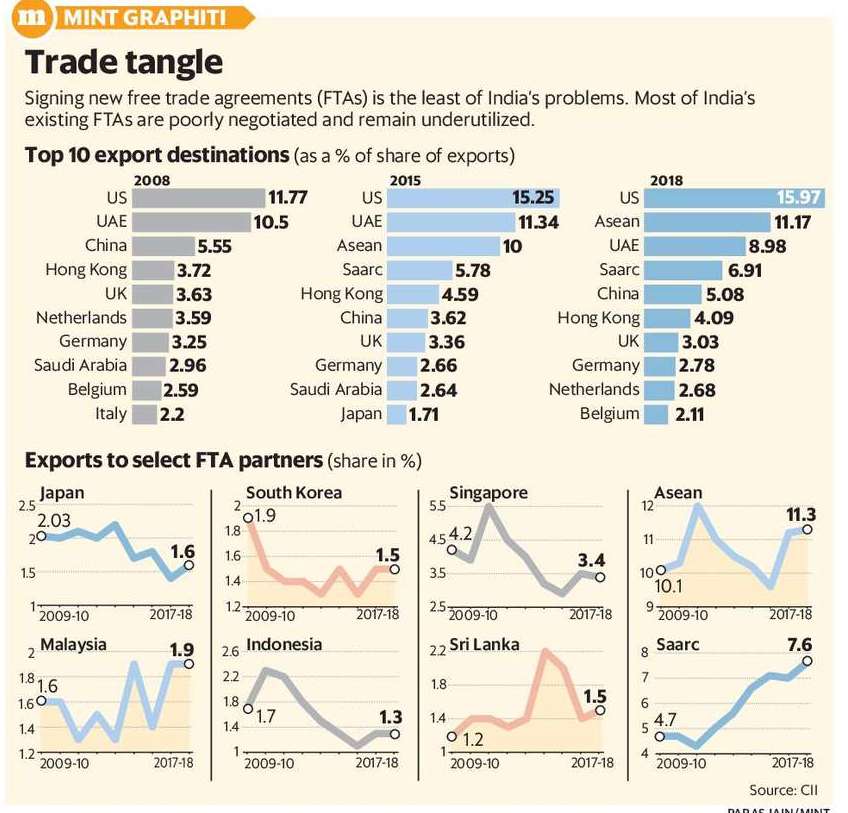
- Most of India’s existing FTAs are poorly negotiated and remain under-utilized.
- For example, in Indonesia, the average tariff for India in non-agricultural goods was 5.5% in 2012, while that for China, it was 2.1%, as a result of the China-Asean FTA.
- This could be because India has been a reluctant globalizer and prefers to sign defensive trade deals that do not hurt domestic industry much, even though it means little additional market access in the partner country.
Way forward
- A nation-wide, cross-sectoral campaign to increase awareness about existing FTAs and the ways in which specific provisions of FTAs can be leveraged by MSMEs would be critical.
- Greater information dissemination about compliance issues are all important for companies to truly be able to take advantage of FTAs
SC REJECTS CURATIVE PLEAS OF 2 NIRBHAYA DEATH ROW CONVICTS
Why in news?
The curative petitions of Vinay Sharma, 26, and Mukesh Singh, 32, who were sentenced to death in the 2012 Nirbhaya gang rape and murder case, were rejected by a five-judge Supreme Court Bench, led by Justice N.V. Ramana, on 14th January 2020.
A party can take only two limited grounds in a curative petition — one, he was not heard by the court before the adverse judgment was passed, and two, the judge was biased.
What is Curative Petition?
- A curative petition is the last constitutional resort available for redressal of grievances in court after a review plea is dismissed or has been exhausted.
- The curative petition is normally decided by judges in-chamber, in rare and exceptional cases, it can be given an open-court hearing.
- A curative petition is a second-time review, but not a matter of right. The court will allow a curative petition only when certain requirements as laid down by it are fulfilled.
- The aggrieved parties have the statutory right to appeal. Once a decision is given by the Supreme Court of India, the same may be considered final and binding.
- However, in the interest of justice, Article 137 was incorporated into the constitution, which provided that the apex court subject to the provisions of any law made by Parliament, the Supreme Court has the power to review any judgment pronounced or order made by it.
Constitutional Provisions regarding Pardoning powers
Article 72
- Article 72 provides the pardoning power to the President of India.
- It says: The President shall
have the power to grant pardons, reprieves, respites or remissions of
punishment or to suspend, remit or commute the sentence of any person
convicted of any offence-
- in all cases where the punishment or sentence is by a Court-martial;
- in all cases where the punishment or sentence for an offence against any law relating to a matter to which the executive power of the Union extends;
- in all cases where the sentence is a sentence of death.
Article 161
- Article 161 provides that the Governor of a State shall have the power to grant pardons, reprieves, respites or remissions of punishment or to suspend, remit or commute the sentence of any person convicted of any offence against any law relating to a matter to which the executive power of the State extends.
- In Dhananjoy Chatterjee alias Dhana v State of West Bengal, 1994 case the Supreme Court has said that “The power under Articles 72 and 161 of the Constitution can be exercised by the Central and State Governments, not by the President or Governor on their own”.
- The advice of the appropriate Government binds the Head of the state.
Different types of Pardoning Powers
Pardon
The president can totally absolve/acquit the person for the offence and let him go free like a normal citizen.
Commute
To reduce the type of punishment into a less harsh one. For example Rigorous imprisonment to simple imprisonment.
Remission
To reduce the punishment without changing the nature of the punishment. For example 20 years rigorous imprisonment to 10 years rigorous imprisonment.
Reprieve
A delay is allowed in the execution of a sentence, usually a death sentence for a guilty person to prove his innocence.
Respite
Reduce the degree of punishment looking at specific grounds like pregnancy, old age etc.
KERALA GOVT. CHALLENGES CAA IN SUPREME COURT
Why in news?
- The State has approached the Supreme Court nearly 15 days after the Assembly unanimously requested the Centre to abrogate the law on December 31, 2019.
- The original suit has been Filed under Article 131 of the Constitution. The SC has “original” jurisdiction in disputes between States or the Centre and State(s).
- The Article allows it to directly take cognisance of such a dispute.
- Kerala said in its suit that it would be compelled under Article 256 to comply with the CAA.
Related Articles in the Constitution
Article 131
- The Article vests the Supreme Court with original jurisdiction over disputes occurring between states or between states and the Centre.
- The original jurisdiction of a court means the power to hear a case for the first time, as opposed to appellate jurisdiction, in which the court reviews the decision of a lower court.
- Unlike the original jurisdiction under Article 32 (which gives the top court the power to issue writs, etc.), the jurisdiction in Article 131 is exclusive, meaning it is only the Supreme Court which has this authority. Under Article 226, the High Courts too have the power to issue writs, directions etc.
Article 256
- According to article 256: The executive power of every State shall be so exercised as to ensure compliance with the laws made by Parliament and any existing laws which apply in that State, and the executive power of the Union shall extend to the giving of such directions to a State as may appear to the Government of India to be necessary for that purpose.
What kinds of disputes are covered under Article 131?
- In ‘State of Rajasthan vs Union of India’, 1977, the Supreme Court ruled that the existence or extent of a legal right is a precursor before a suit under Article 131 is entertained, and that “mere wrangles between governments have no place in the scheme of that Article”, and upheld its jurisdiction in that case.
- Similarly, in the 1978 case, ‘State of Karnataka vs Union of India’, which involved the Centre’s authority to order an inquiry into a state Chief Minister’s conduct, jurisdiction under Article 131 was held valid.
- In the present case filed by Kerala, central legislation (CAA) is being challenged. In 2011, a two-judge Supreme Court Bench in ‘Madhya Pradesh v Union of India’ had held such a suit was not maintainable



